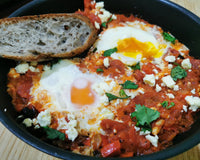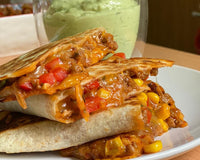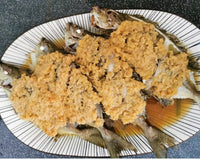Refreshingly honest look into the realities of starting an online business.
Around this time, my business at the wet market was doing ok. I had a little cash on hand. Linus and I decided to go all in on Marketfresh. He would devote more time to Marketfresh while I would invest more money to set up Marketfresh proper. We rented an office and recruited three people, a programmer, a marketer and a designer to help us take Marketfresh to the next level. Linus’ wife, Serene, also volunteered to help us manage the office. I was full of pride when the office was set up. I had always dreamed of working in an office instead of the wet market.
Our plan was to increase our monthly revenue to $50k within a year which will allow us to break even. At this time, our revenue was only $2k a month but our overheads came up to about $10k. We embarked on a series of marketing promotions while creating new content for our Facebook Page. We also incrementally improved the flow of our website and fulfilment process. With this, we managed to increase our revenue by 100% the following month. We were ecstatic, even though it was only a paltry $4K. If we could manage this growth rate, we would be able to hit our target of $50k revenue and break even within 6 months.
For the third month, we hit $6k in sales. It was a 50% increase from the previous month but if sales were to continue to grow at $2k a month, we would not hit $50k for two years at least. With my current cash on hand, we will only be able to last a year. We needed the sales to grow exponentially and fast. One way is to increase ad spending to achieve our desired revenue growth. We did some testing and found that this will not work out for us in the long run. Ad spending comes up to about 10% of revenue consistently. Our gross margin averages out to about 20%. This means that even if we hit our target of $50k sales through increased advertising, we would still be running a deficit.
Another problem I did not foresee was the complications arising from operations and fulfilment due to increased sales. At the very beginning, I personally picked out the groceries by myself. With a handful of orders a day, this was still manageable. However, as the number of orders increased, I realised we had drastically underestimated the challenge of fulfilling orders on the ground. It can take more than 2 hours to buy and sort out the groceries for as little as 10 orders. Delivery is another challenging issue. I delivered the groceries myself and as the orders increased, it became harder and harder to deliver on time.
In order to improve fulfilment efficiency, we engaged the market stallholders to help us with sorting and packing. Now, instead of picking vegetables myself, the uncle and aunties will sort and pack for me into plastic bags labelled with individual order numbers. The same for pork, chicken, beef and all other vendors in the market. I only had to pick them up and then assemble them in order. We extended our morning shipping timing and implemented a cap on the number of orders to manage delivery. These reduced instances of late orders but also increased the chance of missing or wrong orders. There were countless little details that had to be ironed out between the vendors and ourselves and we had to repeat this process every time there is even a small tweak to our fulfilment process. Nevertheless, there is a continual improvement no matter how minor.
Increasing sales turned out to be a lot harder. We went through a myriad of methods, from using bloggers to the distribution of leaflets. We had mixed results, ranging from bad to very bad (hahaha). Sales came along slowly, increasing to $8k on our fourth month and $10k on our fifth month. At least it was not stagnant, we told ourselves.
Around the same time, I started to have cash flow problems with Pan’s Fish due to overzealous expansion. I opened three new stalls in 2017 and two of them turned out to be very expensive duds. In the end, I kept them running for way longer than I should have in the hopes of turning their sales around. With cash flow from Pan’s Fish tied up, I had trouble keeping up with the overheads for the office and salary. Linus knew of the predicament that my business was in. We had frequent discussions to see how we can keep Marketfresh afloat, whether through bank loans or investors.
I began 2017 with about $40k cash on hand. By the end of 2017, I was in debts of over $200k mostly owed to seafood wholesalers and loans from my younger brother. By this point, Linus and I had both worked on Marketfresh for almost two years without having drawn any pay. We both agreed that the direction Marketfresh was taking was unsustainable. We both had our families and young children to take care of and we came to an understanding to go our separate ways. It was an amicable split. Linus and Serene gave me their blessings to continue running Marketfresh on my own.
I still have high hopes for Marketfresh, but it was time to swallow my pride (Tough because it was huge) and proceed with major cost-cutting. The first task at hand was to let go of the office and my employees. I retained Mervyn, who is my designer, and got him to work from home. Now he had to do three persons’ job instead of one, but he was as passionate about Marketfresh as I am so that was no problem. I had to incur additional losses due to breaking the office lease early. I watched with a heavy heart as we cleared out the office. Closing the office was painful financially but even more so emotionally for me (No, I did not cry).
The next thing was to stabilise Pan’s Fish by shuttering non-performing stalls. This was easier and less painful than closing the office. I redeployed my employees to my other stalls. This instantly improved the cash flow, though I would still need a very long time to pare down my payables. By having Mervyn work from home, I also greatly reduced overheads for Marketfresh. By our estimate, we would now need only about $20k of sales a month to break even. A big reduction from the $50k when we still had the office and manpower.
Sales at Marketfresh continued to increase slowly by about $2k a month. At the $14k mark, I was unable to handle fulfilment and delivery alone as I had to tend to my own stall in the wet market at times, especially on the weekends. Instances of missed items and late delivery began to creep up again. Our level of service was taking a hit. I relied on third party couriers like LalaMove to ease the load on delivery but then had to incur losses due to the high cost. For example, a trip by third-party courier costs between $13 to $25 but we only make about $13 per order at the $68 minimum free delivery mark. So, we went ahead and hired our own delivery driver who can also help with sorting and packing in the morning.
I wished I would have hired our driver earlier. It was a revelation how much faster and efficient another pair of hands can make. We eased our fulfilment bottleneck and most of our deliveries are now on time. We can also press ahead to try increase sales without worrying about the stress that it will place on our fulfilment process in the short term.
As I am typing this now, our sales are at the $20k mark. The goal post for profitability has moved from backwards from $20k to $30k due to the hiring of our driver. Marketfresh is still in the red, but cash flow from Pan’s Fish has stabilised. I am still trying to pare down the $200k debt and the needle barely seems to move. I am constantly juggling payments, apologising to creditors over missed payments and asking for extensions the next. The one silver lining is that I am not sinking further into the red.
It has been a very humbling and emotional journey the past year. Whether Marketfresh will make it, in the end, is still a big question. We are an arm’s length away from failure, but we are still experimenting, hoping to find a sliver of success. Our online journey has been very tough, contrary to the success stories that I frequently come across in the media. We are still immensely passionate about Marketfresh and we continue to try our best to make it work. We hope that more people can know about Marketfresh and give us a chance. The quality of produce we have at our wet market is very high and we believe that there is definitely a market for people who want to buy high quality produce online. Now we just have to find enough of them to make it work before our ship sinks.
Please like and follow our Facebook Page as I will be constantly documenting Marketfresh’s journey from here on.






